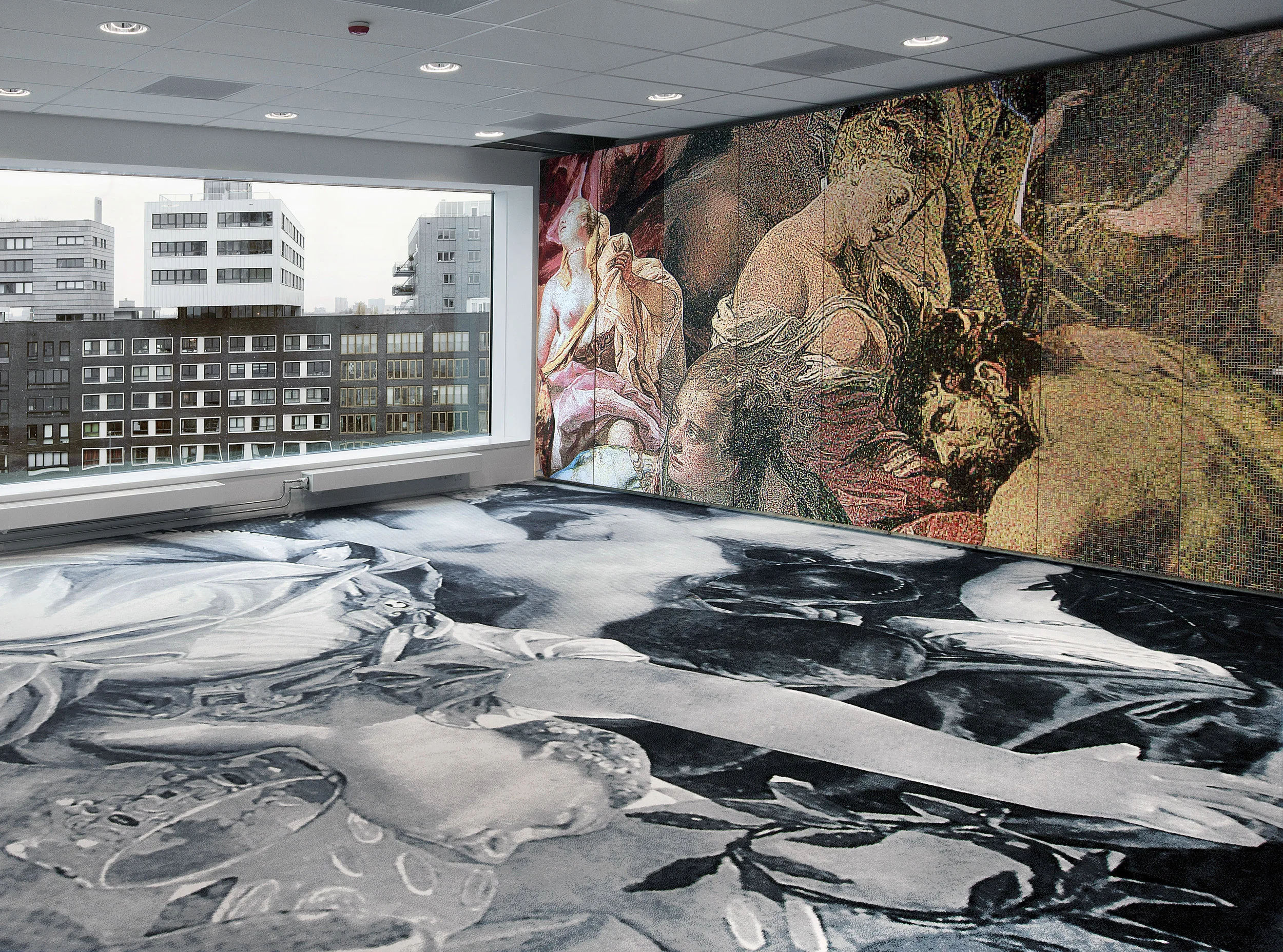Palace of Justice, Amsterdam
Law deals with the consequences of human actions. It is from the good and evil aspects of these human actions that Barbara Broekman draws her inspiration for the artistic scheme of the new Palace of Justice.
Because our current laws are based on the ancient Classical legal system, Broekman has let her depiction of good and evil be based on Classical myths and legends. These ancient stories not only tell of gods, half-gods and their interactions with mortal humans, they also feature the complete range of human emotions: anger, jealousy, fear, love, happiness and sadness. Broekman has used fragments taken from paintings showing various Classical stories, scenes and characters associated with ‘Good’ and ‘Evil’. Some examples are The Rape of the Sabine Women, Time reveals Truth, Justitia and Apollo.
The fragments are taken from Baroque masters like Rubens and Tiepolo. Broekman chose this style very consciously for a number of reasons. The Baroque style accentuates and focuses on emotions and the human element, both themes that play a very important part in Broekman’s work. In her extensive body of works, the merging of micro and macro, or the combining of the personal with the universal are recurring themes. More formal themes such as movement, the play of light, and three-dimensionality on flat surfaces are also typical to both the Baroque and Broekman’s work. Above all, she sees a relation between this style of art, the court of law and the city of Amsterdam. The Royal Palace on Dam Square was once the city’s main court of law. In order to radiate grandeur, status, power, authority and prestige, the building was decorated from top to bottom with a fully Baroque decorative scheme. By using the same style of decoration Broekman draws a direct parallel between the historical palace on Dam Square and the new Palace of Justice.
Another important connection Broekman was aware of when choosing for this artistic style was the relationship between emotion and reason, and how they are represented in the building’s architecture. The building stands for the independence of the law system and the rational language of law. It is through reason that we solve legal conflicts, while the base of these conflicts is often caused by emotion. Both elements are represented in the art applications seen throughout the building.
Broekman selected works of art she thought most relevant to the theme. Using fragments of these works she has made two collages representing good and evil. These collages were then scanned, digitally manipulated and enlarged, resulting in very pixelated images. These enlarged collages serve as a base for the art Broekman has applied throughout the building and in the interior decoration, where fragments can be found on the floors, walls and furniture.
On the floor of the terrace Broekman chose to place a fragment of the painting chosen to represent evil, showing the abduction of Hippodomia. The floor of meeting room 1 features a depiction of good, namely Juno bestowing her gifts on Venice by Veronese. In the same meeting room a fragment from the painting Samson and Delilah by Rubens representing evil has been applied on the doors of a wall-to-wall cupboard. The architectural art, autonomous art and interior decorations have purposely been done in varying materials and techniques. The terrace is made up of a mosaic pattern in pigmented concrete tiles; the carpet is Axminster woven, the autonomous art has been embroidered by hand and the cupboard doors have been covered by Jacquard woven fabrics. Every technique offers a different depiction, thereby enhancing the viewing experience.
Using these various applications and techniques, Broekman makes a statement about the Timeless and the Temporary, and in doing so raises questions about the life span of art and/or design. Once the cupboard doors are worn out, can they be replaced? Should a carpet be restored because it has been created as a work of autonomous art? Or should it be thrown away when it is worn out and replaced by a new one? In her work Broekman often raises such questions about the differences between autonomous and applied art, and by doing so attempts to blur the traditional boundaries between them.
Broekman has succeeded in applying the art in the Palace of Justice in as broad a context as possible, employing it in the building’s architecture, interior decoration and autonomous art, while using different materials and techniques. She has also succeeded in using one concept to create a multitude of different visual experiences. With her art, Broekman not only wants to entice the casual onlooker by using composition, colours and materials to tickle the senses, but also the more engaged viewer who wants to truly experience the art as well as its content. This gives the works a layered effect. From a distance great shapes can be made out, impressive in their size and complexity. From close by one only sees abstract elements, creating a more neutral and reserved image.
In this project Broekman has shown that she is an intermediary between the rigidly separated domains within traditional art history. Her oeuvre shows a melting of the figurative and the abstract, the autonomous and the decorative as well as the timeless and temporary. The interaction between these domains results in a new reality of great visual power and layers of meaning.
